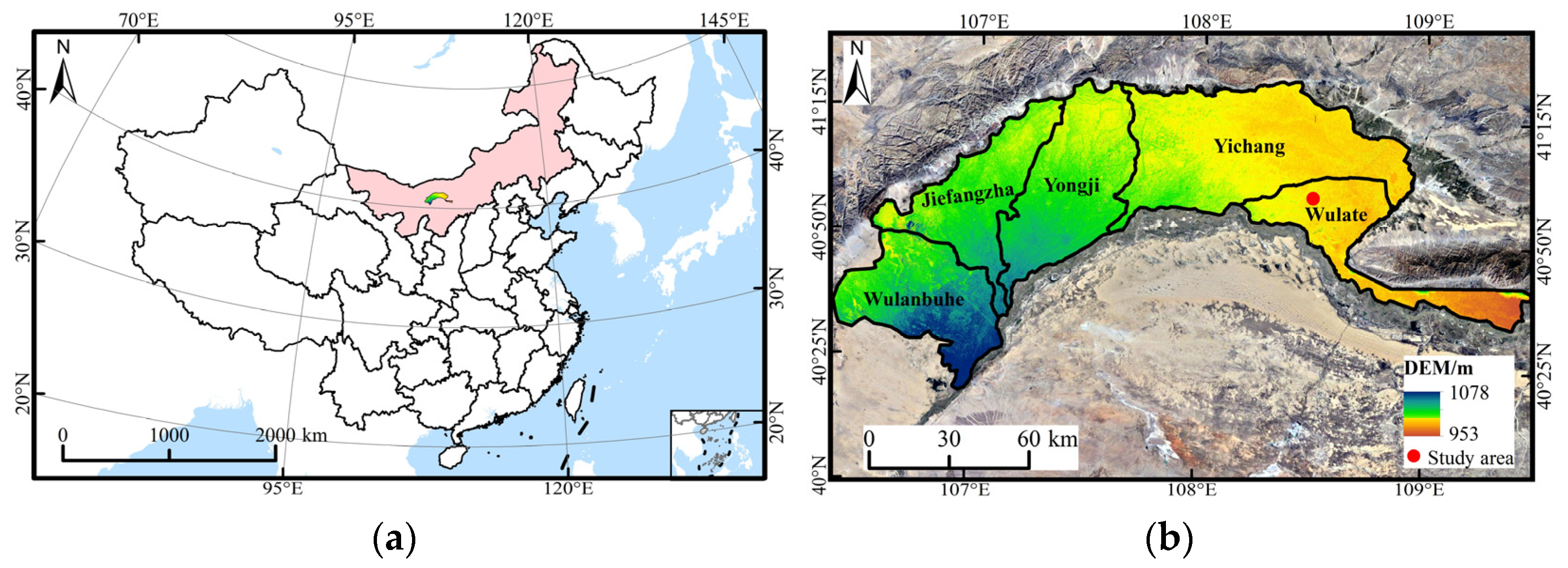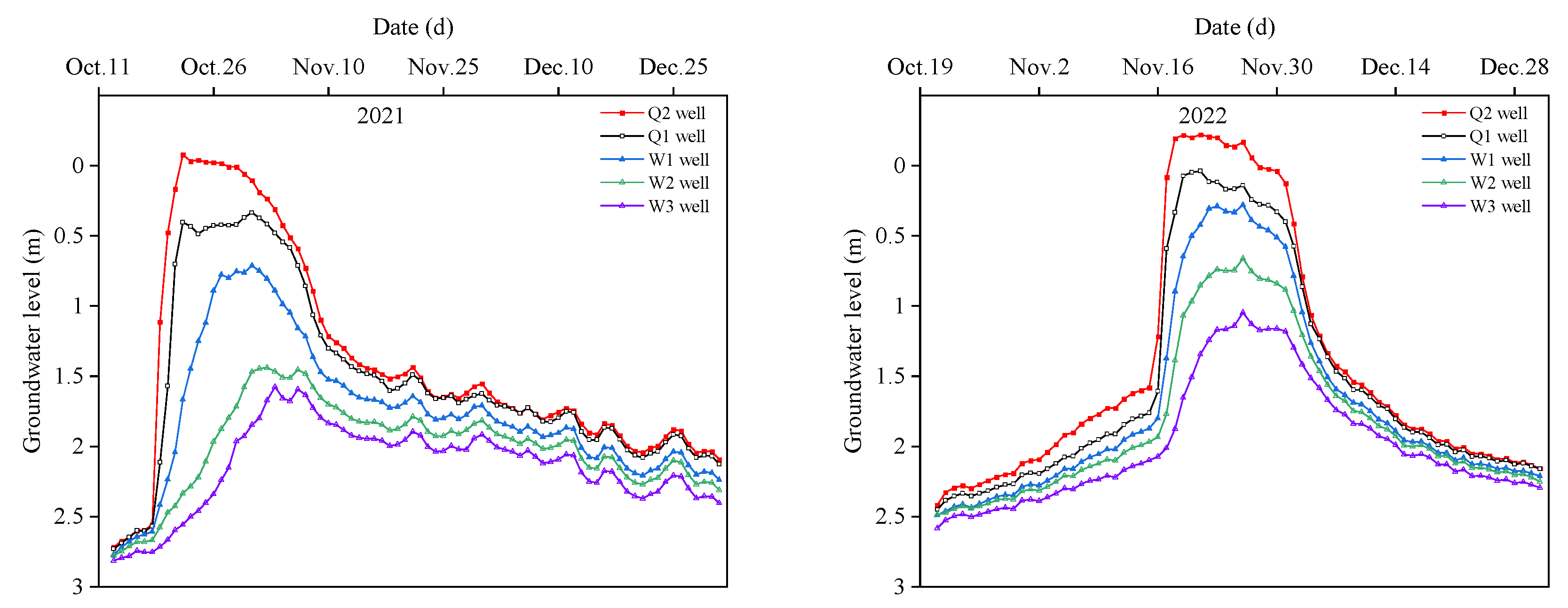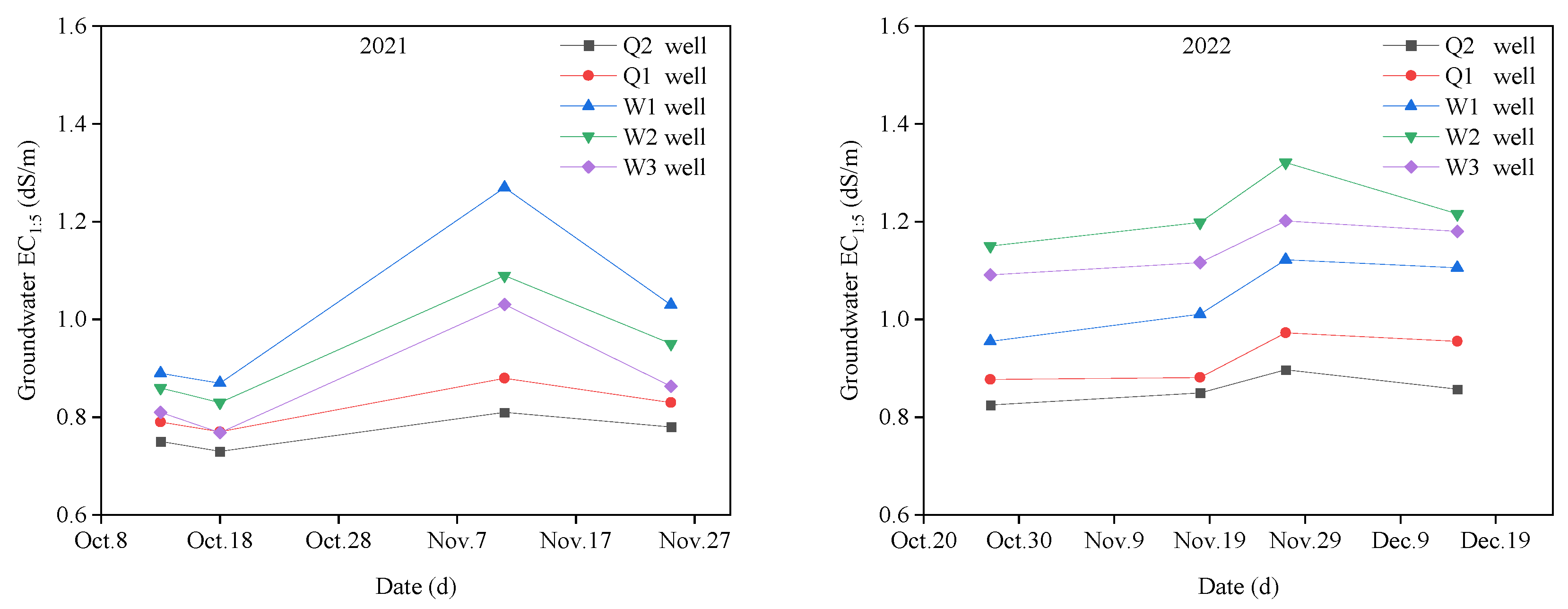Distribution and Variation of Soil Water and Salt before and after Autumn Irrigation
Abstract
:1. Introduction
2. Materials and Methods
2.1. Study Area Description
2.2. Experimental Design
2.3. Data Collection and Measurement
2.4. Research Methods
2.4.1. Changes in Soil Water Content
2.4.2. Soil Desalination Rate
2.4.3. Estimation of Groundwater Table Depths at Soil Sampling Sites
2.5. Data Processing Methods
3. Results
3.1. Distribution Characteristics of Water–Salt in the Soil Profiles
3.1.1. Distribution Characteristics of Water Content in the Soil Profiles
3.1.2. Distribution Characterization of Salt in the Soil Profiles
3.2. Changes in Soil Profile Water Salinity
3.2.1. Changes in Soil Profile Water Content
3.2.2. Changes in Soil Profile Salinity
3.3. Changes in Groundwater Levels and Salinity
3.3.1. Changes in Groundwater Levels
3.3.2. Changes in Groundwater Salinity
4. Discussion
4.1. Effect of Autumn Irrigation on Soil Moisture
4.2. Effect of Autumn Irrigation on Soil Salinity
4.3. Effects of Autumn Irrigation on Groundwater
5. Conclusions
- (1)
- Autumn irrigation improved the uniformity of soil water–salt distributions in AIL but reduced the uniformity of soil water–salt distributions in adjacent NAIL. After autumn irrigation, the maximum difference between the average values of two-year soil water content (salinity) in the horizontal and vertical directions decreased by 75.9% and 25.2% (55.1% and 69.5%) for AIL, respectively, while it increased by 49.4% and 36.9% (61.2% and 36%) for NAIL, respectively.
- (2)
- During the two-year experimental period, autumn irrigation increased the water content of soil profiles in AIL by 38.5~67.7% and 15.5~30.2% and it decreased the salt content by 34.5~54.5% and 21.6~45.3%, respectively. The closer the sampling point to the boundary (Q5), the greater the drainage and salt discharge. In contrast, in NAIL, the soil profile’s water (salt) content increased by 18.3~54.5% and 8.3~19.7% (1.2~14.8% and 1.7%~25%) in the two years, respectively. The closer the sampling point to the boundary, the greater the increase in water–salt content in the soil profile.
- (3)
- After autumn irrigation, the W5, W20, and W45 sampling sites all exhibited large increases in soil profile salinity, with increases of 11.7~14.8% and 23.9~25% within two years, respectively. The average salt accumulation rate was about 5.5 and 6.6 times that of the average salt accumulation rate of sampling points W92, W139, and W186. It can be observed that there was a range limit of the effect of AIL irrigation on the salinity of the soil in NAIL, which was between approximately 45 and 92 m from the boundary. If the limit distance was exceeded, the dry salt discharge effect of the increased NAIL was weakened.
- (4)
- NAIL received drainage from AIL, causing post-irrigation AIL’s groundwater level to decrease rapidly, especially from earlier autumn irrigation, which could reduce the depth of AIL’s groundwater level before freezing to less than 1.5 m. This meets the requirements for the groundwater-designed critical depth in HID. When the autumn irrigation time is delayed to the eve of soil freezing, the depth of the groundwater table in AIL is still above 1.5 m, which will aggravate the risk of salt presence in surface soil during the freeze–thaw period.
Author Contributions
Funding
Data Availability Statement
Acknowledgments
Conflicts of Interest
References
- Li, P.; Ren, L. Evaluating the saline water irrigation schemes using a distributed agro-hydrological model. J. Hydrol. 2021, 594, 125688. [Google Scholar] [CrossRef]
- Ramos, T.B.; Darouich, H.; Oliveira, A.R.; Farzamian, M.; Monteiro, T.; Castanheira, N.; Paz, A.; Alexandre, C.; Gonçalves, M.C.; Pereira, L.S. Water use, soil water balance and soil salinization risks of Mediterranean tree orchards in southern Portugal under current climate variability: Issues for salinity control and irrigation management. Agric. Water Manag. 2023, 283, 108319. [Google Scholar] [CrossRef]
- Cao, Z.; Zhu, T.; Cai, X. Hydro-agro-economic optimization for irrigated farming in an arid region: The Hetao Irrigation District, Inner Mongolia. Agric. Water Manag. 2023, 277, 108095. [Google Scholar] [CrossRef]
- Rosegrant, M.W.; Ringler, C.; Zhu, T. Water for Agriculture: Maintaining Food Security under Growing Scarcity. Annu. Rev. Environ. Resour. 2009, 34, 205–222. [Google Scholar] [CrossRef]
- Ringler, C.; Agbonlahor, M.; Barron, J.; Baye, K.; Meenakshi, J.; Mekonnen, D.K.; Uhlenbrook, S. The role of water in transforming food systems. Glob. Food Secur. 2022, 33, 100639. [Google Scholar] [CrossRef]
- Devkota, K.P.; Devkota, M.; Rezaei, M.; Oosterbaan, R. Managing salinity for sustainable agricultural production in salt-affected soils of irrigated drylands. Agric. Syst. 2022, 198, 103390. [Google Scholar] [CrossRef]
- Feng, W.; Wang, T.; Zhu, Y.; Sun, F.; Giesy, J.P.; Wu, F. Chemical composition, sources, and ecological effect of organic phosphorus in water ecosystems: A review. Carbon Res. 2023, 2, 12. [Google Scholar] [CrossRef]
- Li, L.; Liu, H.; Gong, P.; Lin, E.; Bai, Z.; Li, P.; Wang, C.; Li, J. Multi-objective optimization of winter irrigation for cotton fields in salinized freeze-thaw areas. Eur. J. Agron. 2023, 143, 126715. [Google Scholar] [CrossRef]
- Qadir, M.; Quillérou, E.; Nangia, V.; Murtaza, G.; Singh, M.; Thomas, R.J.; Drechsel, P.; Noble, A.D. Economics of salt-induced land degradation and restoration. Nat. Resour. Forum 2014, 38, 282–295. [Google Scholar] [CrossRef]
- Singh, A. Soil salinization management for sustainable development: A review. J. Environ. Manag. 2021, 277, 111383. [Google Scholar] [CrossRef]
- Chang, X.; Gao, Z.; Wang, S.; Chen, H. Modelling long-term soil salinity dynamics using SaltMod in Hetao Irrigation District, China. Comput. Electron. Agric. 2019, 156, 447–458. [Google Scholar] [CrossRef]
- Ramos, T.B.; Liu, M.; Paredes, P.; Shi, H.; Feng, Z.; Lei, H.; Pereira, L.S. Salts dynamics in maize irrigation in the Hetao plateau using static water table lysimeters and HYDRUS-1D with focus on the autumn leaching irrigation. Agric. Water Manag. 2023, 283, 108306. [Google Scholar] [CrossRef]
- Tan, X.; Wu, J.; Wu, M.; Huang, J.; Tan, B.; Li, L. Effects of ice cover on soil water, heat, and solute movement: An experimental study. Geoderma 2021, 403, 115209. [Google Scholar] [CrossRef]
- Chen, H.; Peng, Z.; Zeng, W.; Wu, J. Salt Movement during Soil Freezing Events in Inner Mongolia, China. J. Coast. Res. 2018, 82, 55–63. [Google Scholar] [CrossRef]
- Liu, J.; Huang, Q.; Li, Z.; Liu, N.; Li, J.; Huang, G. Effect of Autumn Irrigation on Salt Leaching under Subsurface Drainage in an Arid Irrigation District. Water 2023, 15, 2296. [Google Scholar] [CrossRef]
- Lu, X.; Li, R.; Shi, H.; Liang, J.; Miao, Q.; Fan, L. Successive simulations of soil water-heat-salt transport in one whole year of agriculture after different mulching treatments and autumn irrigation. Geoderma 2019, 344, 99–107. [Google Scholar] [CrossRef]
- Ansari, S.; Abedi-Koupai, J.; Mostafazadeh-Fard, B.; Shayannejad, M.; Mosaddeghi, M.R. Assessment of solute transport and distribution under dry drainage conditions using a physical model. Irrig. Drain. 2019, 68, 797–807. [Google Scholar] [CrossRef]
- Wichelns, D.; Oster, J. Sustainable irrigation is necessary and achievable, but direct costs and environmental impacts can be substantial. Agric. Water Manag. 2006, 86, 114–127. [Google Scholar] [CrossRef]
- Abedi-Koupai, J.; Ansari, S.; Mostafazadeh-Fard, B.; Shayannejad, M.; Mosaddeghi, M.R. Experimental study and numerical simulation of soil water and salt transport under dry drainage conditions. Environ. Earth Sci. 2020, 79, 89. [Google Scholar] [CrossRef]
- Konukcu, F.; Gowing, J.; Rose, D. Dry drainage: A sustainable solution to waterlogging and salinity problems in irrigation areas? Agric. Water Manag. 2006, 83, 1–12. [Google Scholar] [CrossRef]
- Zhang, W.; Shi, H.; Li, Z.; Wang, W.; Fu, X.; Li, Z. Redistribution Mechanism for Irrigation Water and Salinity in Typical Irrigation and Drainage Unit in the Hetao Irrigation District, China. J. Irrig. Drain. Eng. 2022, 148, 04022021. [Google Scholar] [CrossRef]
- Wu, J.; Zhao, L.; Huang, J.; Yang, J.; Vincent, B.; Bouarfa, S.; Vidal, A. On the effectiveness of dry drainage in soil salinity control. Sci. China Technol. Sci. 2009, 52, 3328–3334. [Google Scholar] [CrossRef]
- Wei, F.; Shen, C.; Liu, J.; Wu, J. Analysis Based on Numerical Simulation on the Influencing Factors of Salinity Control Effect of Dry Drainage. China Rural Water Hydropower 2015, 5, 85–90. [Google Scholar]
- Yang, X.; Zhu, Q.; Ma, M.; Wu, J. Research on the Evaporation Capacity and Water—Salt VariationCharacteristics of Different Types of Saline Wasteland. China Rural Water Hydropower 2019, 9, 49–53. [Google Scholar]
- Wang, C.; Wu, J.; Zeng, W.; Zhu, Y.; Huang, J. Five-year experimental study on effectiveness and sustainability of a dry drainage system for controlling soil salinity. Water 2019, 11, 111. [Google Scholar] [CrossRef]
- Liu, G.; Wang, C.; Wang, X.; Huo, Z.; Liu, J. Growing season water and salt migration between abandoned lands and adjacent croplands in arid and semi-arid irrigation areas in shallow water table environments. Agric. Water Manag. 2022, 274, 107968. [Google Scholar] [CrossRef]
- Mao, W.; Zhu, Y.; Wu, J.; Ye, M.; Yang, J. Evaluation of effects of limited irrigation on regional-scale water movement and salt accumulation in arid agricultural areas. Agric. Water Manag. 2022, 262, 107398. [Google Scholar] [CrossRef]
- Shi, H.; Yang, S.; Li, R.; Li, X.; Li, W.; Yan, J.; Miao, Q.; Li, Z. Soil Water and Salt Movement and Soil Salinization Control in Hetao Irrigation District: Current State and Future Prospect. J. Irrig. Drain. Eng. 2020, 39, 1–17. [Google Scholar] [CrossRef]
- Fan, L.; Shi, H.; Yan, J.; Li, X.; Dou, X.; Qi, Q.; Li, H. Analysis of Soil Water and Salt Redistribution during the Freeze-thaw Periodin “Autumn Watering-spring Irrigation”. J. Irrig. Drain. Eng. 2023, 42, 90–97+113. [Google Scholar] [CrossRef]
- Peng, Z.; Wu, J.; Huang, J. Water and salt movement under partial irrigation in Hetao Irrigation District, Inner Mongolia. J. Hydraul. Eng. 2016, 47, 110–118. [Google Scholar] [CrossRef]
- Dou, X.; Shi, H.; Li, R.; Miao, Q.; Tian, F.; Yu, D. Distribution Characteristics of Salinity and Nutrients in Salinized Soil. Trans. Chin. Soc. Agric. Mach. 2022, 53, 279–290+330. [Google Scholar] [CrossRef]
- Wang, R.; Wan, H.; Chen, S.; Xia, Y.; Bai, Q.; Peng, Z.; Shang, S. Spatial distribution pattern of soil salinization in farmland of Wulate sub-irrigation areas in Hetao Irrigation District in Inner Mongolia in spring. Trans. Chin. Soc. Agric. Eng. 2021, 37, 105–113. [Google Scholar]
- Wu, K.; Zhao, R. Soil Texture Classification and Its Application in China. Acta Pedol. Sin. 2019, 56, 227–241. [Google Scholar] [CrossRef]
- Allen, R.G.; Pereira, L.S.; Raes, D.; Smith, M. Crop Evapotranspiration (Guidelines for Computing Crop Water Requirements); FAO Irrig. Drain. Paper No. 56; FAO: Rome, Italy, 1998. [Google Scholar]
- Guo, S. Influence of Autumn Irrigation time upon Moisture-Salt Movement and Agricultural Environment in Hetao Irrigation Area of Inner Mongolia. J. China Agric. Univ. 1997, S1, 147–150. [Google Scholar]
- Wen, Y.; Wan, H.; Shang, S. A monthly distributed water and salt balance model in irrigated and non-irrigated lands of arid irrigation district with shallow groundwater table. J. Hydrol. 2023, 616, 128811. [Google Scholar] [CrossRef]
- Wu, T.; Li, H.; Lyu, H. Effect of freeze–thaw process on heat transfer and water migration between soil water and groundwater. J. Hydrol. 2023, 617, 128987. [Google Scholar] [CrossRef]
- Feng, Z.-Z.; Wang, X.-K.; Feng, Z.-W. Soil N and salinity leaching after the autumn irrigation and its impact on groundwater in Hetao Irrigation District, China. Agric. Water Manag. 2005, 71, 131–143. [Google Scholar] [CrossRef]
- Yin, X.; Feng, Q.; Zheng, X.; Zhu, M.; Wu, X.; Guo, Y.; Wu, M.; Li, Y. Spatio-temporal dynamics and eco-hydrological controls of water and salt migration within and among different land uses in an oasis-desert system. Sci. Total Environ. 2021, 772, 145572. [Google Scholar] [CrossRef] [PubMed]
- Wang, T.; Feng, W.; Liu, J.; Fan, W.; Li, T.; Song, F.; Yang, F.; Liao, H.; Leppäranta, M. Eutrophication in cold-arid lakes: Molecular characteristics and transformation mechanism of DOM under microbial action at the ice-water interface. Carbon Res. 2024, 3, 42. [Google Scholar] [CrossRef]
- Soltani, M.; Rahimikhoob, A.; Sotoodehnia, A.; Mendicino, G.; Akram, M.; Senatore, A. Numerical evaluation of the effects of increasing ratio of cropped to uncropped width on dry drainage efficiency in salty soils. Irrig. Drain. 2018, 67, 91–100. [Google Scholar] [CrossRef]
- Malakar, A.; Snow, D.; Ray, C. Irrigation Water Quality-A Contemporary Perspective. Water 2019, 11, 1482. [Google Scholar] [CrossRef]
- Yuan, C.; Feng, S.; Zhuang, X.; Qian, Z. Analyzing water-salt dynamics in typical cultivated and wasteland in Hetao irrigation district of Inner Mongolia. Agric. Res. Arid. Areas. 2022, 40, 76–85. [Google Scholar] [CrossRef]
- Huang, Y.; Ma, Y.; Zhang, S.; Li, Z.; Huang, Y. Optimum allocation of salt discharge areas in land consolidation for irrigation districts by SahysMod. Agric. Water Manag. 2021, 256, 107060. [Google Scholar] [CrossRef]
- Khasanov, S.; Li, F.; Kulmatov, R.; Zhang, Q.; Qiao, Y.; Odilov, S.; Yu, P.; Leng, P.; Hirwa, H.; Tian, C. Evaluation of the perennial spatio-temporal changes in the groundwater level and mineralization, and soil salinity in irrigated lands of arid zone: As an example of Syrdarya Province, Uzbekistan. Agric. Water Manag. 2022, 263, 107444. [Google Scholar] [CrossRef]
- Shokri-Kuehni, S.M.; Raaijmakers, B.; Kurz, T.; Or, D.; Helmig, R.; Shokri, N. Water table depth and soil salinization: From pore-scale processes to field-scale responses. Water Resour. Res. 2020, 56, e2019WR026707. [Google Scholar] [CrossRef]
- Askri, B.; Khodmi, S.; Bouhlila, R. Impact of subsurface drainage system on waterlogged and saline soils in a Saharan palm grove. Catena 2022, 212, 106070. [Google Scholar] [CrossRef]











| Land Types | Soil Depth (cm) | Particle Distribution (%) | Soil Bulk Density (g cm−3) | Soil Texture | ||
|---|---|---|---|---|---|---|
| Clay (<0.002 mm) | Silt (0.002–0.05 mm) | Sand (0.05–2 mm) | ||||
| 0–5 | 2.29 | 43.18 | 54.53 | 1.51 | Sandy loam | |
| 5–20 | 2.45 | 43.30 | 54.25 | 1.55 | Sandy loam | |
| 20–40 | 2.25 | 55.62 | 42.13 | 1.57 | Silty loam | |
| AIL | 40–60 | 1.11 | 55.66 | 43.23 | 1.52 | Silty loam |
| 60–80 | 0.79 | 54.67 | 44.54 | 1.53 | Silty loam | |
| 80–100 | 0.21 | 27.22 | 72.57 | 1.61 | Loamy sand | |
| 100–150 | 0.21 | 21.34 | 78.45 | 1.62 | Loamy sand | |
| 150–200 | 0.36 | 10.38 | 89.26 | 1.62 | Loamy sand | |
| 0–5 | 2.68 | 40.11 | 57.21 | 1.50 | Sandy loam | |
| 5–20 | 2.26 | 30.22 | 67.52 | 1.55 | Sandy loam | |
| 20–40 | 3.75 | 60.60 | 35.64 | 1.60 | Silty loam | |
| NAIL | 40–60 | 4.90 | 54.73 | 40.37 | 1.54 | Silty loam |
| 60–80 | 1.89 | 63.22 | 34.90 | 1.51 | Silty loam | |
| 80–100 | 0.85 | 52.67 | 46.47 | 1.55 | Silty loam | |
| 100–150 | 0.25 | 21.31 | 78.44 | 1.62 | Loamy sand | |
| 150–200 | 0.27 | 20.55 | 79.18 | 1.63 | Loamy sand | |
Disclaimer/Publisher’s Note: The statements, opinions and data contained in all publications are solely those of the individual author(s) and contributor(s) and not of MDPI and/or the editor(s). MDPI and/or the editor(s) disclaim responsibility for any injury to people or property resulting from any ideas, methods, instructions or products referred to in the content. |
© 2024 by the authors. Licensee MDPI, Basel, Switzerland. This article is an open access article distributed under the terms and conditions of the Creative Commons Attribution (CC BY) license (https://creativecommons.org/licenses/by/4.0/).
Share and Cite
Zhang, Y.; Miao, Q.; Li, R.; Sun, M.; Yang, X.; Wang, W.; Huang, Y.; Feng, W. Distribution and Variation of Soil Water and Salt before and after Autumn Irrigation. Land 2024, 13, 773. https://doi.org/10.3390/land13060773
Zhang Y, Miao Q, Li R, Sun M, Yang X, Wang W, Huang Y, Feng W. Distribution and Variation of Soil Water and Salt before and after Autumn Irrigation. Land. 2024; 13(6):773. https://doi.org/10.3390/land13060773
Chicago/Turabian StyleZhang, Yin, Qingfeng Miao, Ruiping Li, Minghai Sun, Xinmin Yang, Wei Wang, Yongping Huang, and Weiying Feng. 2024. "Distribution and Variation of Soil Water and Salt before and after Autumn Irrigation" Land 13, no. 6: 773. https://doi.org/10.3390/land13060773
APA StyleZhang, Y., Miao, Q., Li, R., Sun, M., Yang, X., Wang, W., Huang, Y., & Feng, W. (2024). Distribution and Variation of Soil Water and Salt before and after Autumn Irrigation. Land, 13(6), 773. https://doi.org/10.3390/land13060773










